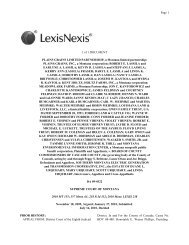Through a Glass Darkly: Measuring Loss Under ... - Land Use Law
Through a Glass Darkly: Measuring Loss Under ... - Land Use Law
Through a Glass Darkly: Measuring Loss Under ... - Land Use Law
You also want an ePaper? Increase the reach of your titles
YUMPU automatically turns print PDFs into web optimized ePapers that Google loves.
MEASURING LOSS UNDER MEASURE 37 599<br />
a strict legal analysis; nevertheless, it is important to analyze Sercombe’s<br />
valuation from an economic, as well as legal, perspective. The analysis is<br />
thoughtful and well-written and is the only comprehensive legal analysis<br />
of value. If it has flaws, it is because it attempts to reconcile the silence, the<br />
vagueness, and the contradictory provisions of the Measure itself.<br />
Sercombe concludes that a court, following the statutory interpretation<br />
methodology set out in Portland General Electric Co. v. Bureau of<br />
Labor & Industries, 121 and relying on the textual, contextual, and legislative<br />
history of Measure 37, should determine that “just compensation”<br />
under section 197.352 is equal to the “actual reduction in the fair market<br />
value of the property or comparable land before and after the enactment<br />
of the regulation. This value would be augmented or inflated to provide<br />
a rate of return on investment to the date of the claim [hereinafter known<br />
as ‘interest’].” 122<br />
It is important to note that the reduction he refers to is the devaluation<br />
caused by the textual or facial effect of the land use regulation: in other<br />
words, the devaluation in the property value caused immediately by the<br />
enactment of the land use regulation, and not by any long-term, unpredicted,<br />
or indirect consequences that the regulation may have. 123 Fundamental<br />
to this methodology is the fact that both values are to be assessed<br />
at the time of the enactment of the regulation, and the differential then<br />
augmented by the interest that the owner would have received on the<br />
differential to the date of the claim. 124<br />
Although Sercombe does not explicitly refer to a formula for calculating<br />
loss, the following formula can be inferred from the hypothetical<br />
scenario he provides in his memorandum. 125<br />
Public Payment Lost Value (1 Interest Rate) n<br />
121. 859 P2.d 1143 (Or. 1993).<br />
122. Memorandum from Timothy J. Sercombe to Robert E. Stacy, Jr., Executive<br />
Director, 1000 Friends of Oregon, Meaning of “Just Compensation” under OR. REV.<br />
STAT. § 197.352(2) and Modification of <strong>Land</strong> <strong>Use</strong> Regulation under OR. REV. STAT.<br />
§ 197.352(8) (June 15, 2006) (emphasis added) (on file with author).<br />
123. If the highest and best value of a plot of land is as residential property, and a<br />
land use regulation rezones the land as farmland, the “facial devaluation” will equal the<br />
difference between the fair market value of the land as residential property and the fair<br />
market value of the land as farm land on the day the legislation took effect.<br />
124. The rate of return can be seen to represent the interest on the compensation that<br />
the owner would have received up to the date of the claim had the compensation been<br />
paid to the owner at the date of the enactment of the regulation.<br />
125. Sercombe, supra note 122, at 16 n.8. The literal interpretation of Sercombe’s<br />
hypothetical scenario actually results in the formula Public Payment Lost Value <br />
Lost Value (1 Rate of Return)n. However this formula does not appear to be<br />
ABA-TUL-07-0701-Sullivan.indd 599<br />
9/18/07 10:43:43 AM







